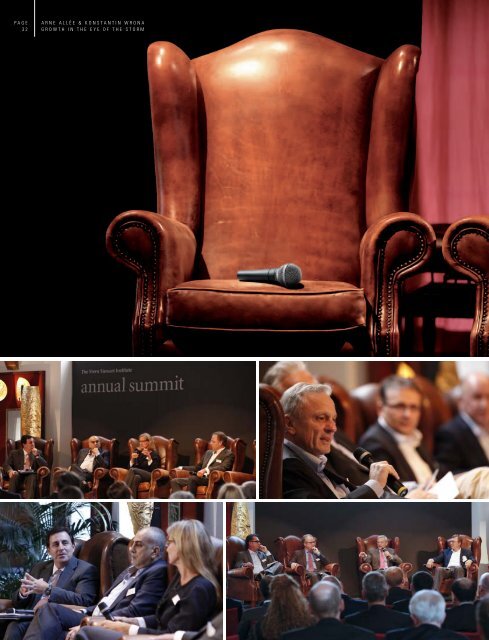View PDF - Stern Stewart Institute
View PDF - Stern Stewart Institute
View PDF - Stern Stewart Institute
- No tags were found...
You also want an ePaper? Increase the reach of your titles
YUMPU automatically turns print PDFs into web optimized ePapers that Google loves.
the authorsKonstantin Wrona & Arne AlléePartners<strong>Stern</strong> <strong>Stewart</strong> & Co.page33The <strong>Stern</strong> <strong>Stewart</strong> <strong>Institute</strong>Annual Summit 2012 Review:What Leaders ThinkReview of the DiscussionsHeld at the 14th Annual Summit of The <strong>Stern</strong> <strong>Stewart</strong> <strong>Institute</strong>at Schloss Elmau in September 2012What will follow the meltdown of 2008/2009 and thesubsequent recovery of 2010/11? We are surrounded bydark clouds but the air is still mild. If this is just the eye ofa larger storm ready to pick up again, how are we goingto drive growth? This was the focus of this year’s AnnualSummit of the <strong>Stern</strong> <strong>Stewart</strong> <strong>Institute</strong> which convened atSchloss Elmau from 13-16 September.figure 11. What real GDP growth do you expect concerning the worldeconomy in 2013? And what average for the next 5 years?Real GDP growth>5%3-5%2-3%0-2%
page34Arne Allée & Konstantin WronaGrowth in the Eye of the Stormfigure 22. What are you preparing your organization for these days?figure 35. What would be the effect of a euro break-down for your company?4%12%40%34%10%Strong upswingSlight upswingUpmost flexibility for bothSlight downturnStrong downturnStrongly negative 29%rather negative 46%neutral 24%positive 1%20% 40% 60% 80% 100%But when looking at probable scenarios, the mood is morepessimistic than a year ago. Steady growth in Westerneconomies is becoming more unlikely (-5 percent) whileinflationary tendencies have gained support by +13 percent.Overall, participating organizations are more likelyto prepare for a downturn (44 percent vs. 16 percent for anupswing). But, as many as 40 percent maintain flexibilityfor both (see figure 2).The likelihood of global disruptionBut there is more. Besides the cyclic and systemic dangersto the world economy, global disruption might arise froma major crisis as a result of the instability in the MiddleEast. Although the events are dominating the eveningnews, our ability to predict developments like the JasmineRevolution in the Arab world is limited as is the knowledgeabout the future course of major players such as Egypt.“There are many places we aren’t watching” meaning theinability to distinguish and identify people within theregion who might be allies for stability and peaceful development.The panel stated that while the sanctions on Iranare beginning to have an impact, further action is unclear.An attack would pose a considerable risk to the economysince it would take months to restore oil production oncetaken out. Refraining from attacking Iran and isolating itfurther into submission might lead other neighbors suchas Turkey and Saudi Arabia to become nuclear powers aswell. Yet, containment and deterrence already appear to beworking.»Non-OPEC supply has disappointedin the last 4-5 years.«Break-up of the euro zone?Two years ago, the Executive Vice Chairman of the Bankof America, Merrill Lynch, predicted no major Europeandefaults but “some government to falter” and “newlyelected leaders”. This prediction turned out to be true.Apart from Greece, a large majority of the participantsdoes not expect the euro zone to lose members but stronglysupports a Marshall plan to rescue southern EMU countries.This goes along with the Bundes bank’s determinationto maintain the euro.»The Bundesbank’s refusal to accept4 percent inflation is the guarantee thatthe euro will break up.«This might be in part because 75 percent expects a negativeor strongly negative effect on their companies (see figure 3)whereas just 1 percent expects a positive one. So, onething seems to be certain and that is that a break-upwould be a disaster. Will it? The clear dividing line ofopinions was the British Channel. Not only were Anglo-Saxon participants anticipating the break-up of the euroor a northern double currency by a “50 percent chance”,but for them it didn’t seem disastrous at all. The key pointfor both sides was the ability of European states to change.
Arne Allée & Konstantin WronaGrowth in the Eye of the Stormpage35To adapt to a more Central and Northern European financephilosophy, the German style, as some have put it.All were in agreement, however, that this should not resultin too much domination.The well-publicized euro calamities might hide the weaknessesof others. So, it is unclear whether the US dollaris doing that much better. The participants expect theexchange rate to remain between 1.2 and 1.3, so, exactlywhere it is today.The German “energy turnaround”:Oil to the fire or turbo for innovation?As the euro crisis distracts from other world affairs,the question remains whether the German decision todrastically switch from nuclear power and fossil fuels torenewable power generation will isolate Germany withinEurope. There was a strong suggestion that oil prices willrise dramatically by 2020. Fifty-two percent sees realprices soaring by more than 50 percent whereas only 9percent sees them shrinking (see figure 4). And, still, theeffects of subsidies versus technological progress on renewableenergy prices are undecided (see figure 5). Therewas a strong call for ensuring the latter by fostering privateenterprise instead of planned government programs. Theoverall perception, however, is undeniably optimistic.Although energy saving programs started well over 30years ago, only 6 percent expects no progress in that sector(see figure 6). The large majority is expecting more or lessconsiderable progress. What’s more, the positive impacton the market position and jobs ranks highest amongall (see figure 7). Even with its regulatory downside andstate intervention, 54 percent of the audience still sees thedevelopment as the right framework for German business.The disagreeing minority, however, was comprised ofthose who have to provide the technical solutions to meetthe demand. So, this question will remain an open topicfor years to come.figure 41. Despite the very difficult economic situation, oil prices remain atrecord-high levels. What do you think will be oil price by 2020?Oil price in 2020 compared to today(in real € terms)Response+100% 15%+50% 37%+20% 31%0% 8%-10% 6%-25% 3%-50% 0%figure 52. Do you think the cost of electricity generated from renewableenergy will be higher by 2020?Renewable energy price in 2020(in real € terms)Response+100% 6%+50% 10%+20% 34%0% 5%-10% 10%-25% 28%-50% 6%figure 63. On a like-for-like basis how much scope do you think there is foryour business to reduce your energy consumption by 2020?Energy saving potential by 2020figure 74. How would you rank the following in terms of what theGerman „Energiewende“ should be aiming to achieve?The impact on the perception ofGermany as the global leader ingreen technologyThe impact on jobs in the economyThe impact on the environmentThe impact on the cost of energyThe impact on the security ofenergy supplyimportanceResponseNone at all 6%0-10% 25%10-20% 46%20-50% 21%>50% 2%122.02.52.83.3ranking4.13 4 5rating average (scale 1-5)
page36Arne Allée & Konstantin WronaGrowth in the Eye of the Storm»The subsidies in the oil-exportingcountries dwarf [those] in Germany onrenewable energy.«Growth opportunities and the roleof financeThe economy is fueled by cash but banks have been and inpart still are a major source of concern. “Eighty-five percentof liquidity in the US is generated by commercial, only 15percent by central banks”. While a majority of 87 percentsees more bank regulation such as Basel III, half of thosefeel that there will eventually be workarounds limitingthe effect (see figure 8). A large majority of the summitparticipants (61 percent) opts for splitting up banks intocommercial and investment banks and calls for additionalcapital-providing sources such as insurance companies.However, when it comes to securing financing, operationalmeasures to optimize the operating cashflow outweighfinancing techniques. And when it comes to growth,financial requirements rank behind the more importantsourcing restrictions.provide growth opportunities because they are at thecenter of innovation. The panel favored the approachwhereby more effort is spent taking an in-depth look atcompany-specific markets, applications and industries.Growth is everywhere as one put it and even “good oldEurope still has a lot of world class companies”. “Growth iseverywhere not just in BRIC”, “BRIC is out” and otherstatements showed that business leaders were lookingmore at their company’s individual growth opportunities.Bigger and more complexorganizations?How should growth and market shifts be managed? Here,the adaption of business models reaches highest scores,leaving second place for performance excellence measures,only (see figure 9).figure 95. Which are key instruments to make your organization moreadaptable to market swings?rankingShift towards after sales /servicesSupply moves /plant relocations5.55.9figure 81. More regulation (as Basel III) will make the financial industry ...Outsourcing /reduced value added4.744%43%13%SAFERbecause banks will have to maintain higher core equity ratios andsufficient liquidity which will lead to less risk taking.More secureonly for a very short period of time, because money has alwaysfound other business not affected by regulation.Less secure,as banks will then only be able to offer just a few alternativesof financing which will lead to new risk concentrations.importanceOrganizational structuresPeople developmentAdvanced planning /forecast systemsLabor agreements (e.g. moretemporary work, pay schemes)Diversification ofbusiness activities3.43.74.14.14.0123 4 5 6 7 8rating average (scale 1-8)Focusing too much on BRIC countries alone doesn’t seemto be reasonable. In general, growth occurs everywherenot only in acronym regions and for reasons that even gobeyond demographics and urbanization. The panel agreedthat aging regions such as Europe or Japan, for example,»It’s all about cost efficiency. You haveto be better than the others. The problemwith the cost of complexity is thatyou can’t see it.«
Arne Allée & Konstantin WronaGrowth in the Eye of the Stormpage37Organizations that target and have to cope with growthand growing business complexity seem to call for evenmore complex matrix organizations. One-third of therepresented companies is already organized that way. Anda mere 1 percent operates in a regional organization.However, the participants expressed skepticism towardsmatrix organizations. An organization that is too complexwith overlapping responsibilities was thought to divert attentionaway from core aspects such as customers,cultural differences and quick decision-making.»Everybody talks about responsibilitiesregarding functions; nobody talksabout customers.«There was a great deal of uncertainty about how to makean organizational change work while at the same time51 percent of the audience thought that they will haveto change their organizational setup eventually. Not havingtotal confidence in today’s organizational principles,participants still expressed reluctance to change it now. Thepanel discussion then went on to emphasize people, theirpersonalities and culture since global expansion givescultural differences a more important role while, at thesame time, the broadening education of emerging marketmanagers in Europe and the US also actively changes theirsocieties when they come home.While only a minority (19 percent) expressed their viewthat complexity is not a given at all, only 40 percent wouldattribute this to external factors such as market or governance.An overwhelming 85 percent is convinced that theactual degree of complexity in their companies doesn’tharm reaction speed, but almost the same majority(74 percent) is sure that complexity is hurting success.There are techniques to manage complexity and keep costsin check such as creating shared service centers thoughnot all panelists were sure to have them at their disposal.Keeping structures such as legal entities, products andbusiness models low seemed to be a good starting point.Consequently, there is an upcoming issue of the trade-offbetween growth, organizational complexity and culturalmatters that has been recognized but not fully addressedlet alone solved. ✺»Fast decisions are made but how fastare they implemented?«»We hire people for their abilities andfire them for their personalities.«




